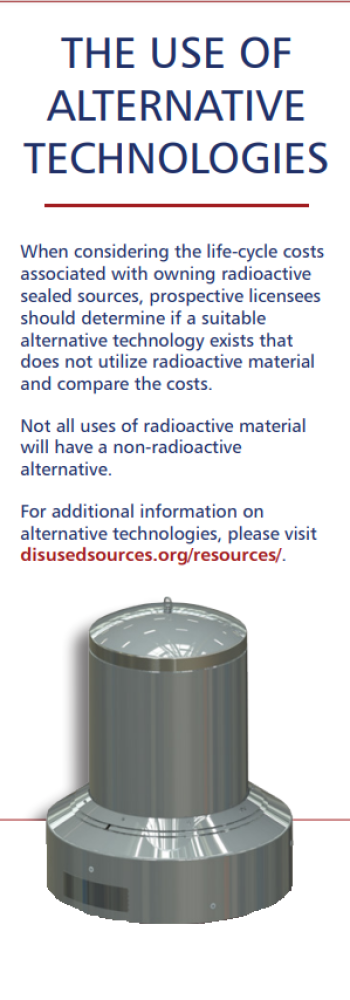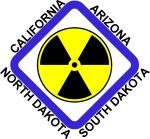POTENTIAL LIABILITIES OF USING
RADIOACTIVE SEALED SOURCES OR DEVICES
________________________________
As the owner of a radioactive sealed source or device, you are legally responsible for its proper management and use and can be liable for the consequences should your radioactive material damage the environment or create a public health and safety impact.
The U.S. Government Accountability Office has estimated that an average of 250 sealed sources are lost, stolen or abandoned each year. While most are recovered, some are not.
In today’s national security environment, some sealed sources pose a threat to the public as they could be used individually or in aggregate in a radiological dispersal device (RDD or dirty bomb) or a radiation exposure device (RED). Based on past emergency response training exercises, the U.S. Environmental Protection Agency (EPA) has estimated that an RDD incident in a major metropolitan area could result in 39 million cubic feet and 10 billion gallons of
radioactively contaminated waste requiring disposal.1
Care must be taken to protect sealed sources and devices while in use. Radioactive sealed sources and devices must be stored securely when not in use.
Disused sources must be properly secured to prevent loss, theft or other malevolent use and should be disposed in a timely manner. The loss of radioactive material should be reported immediately to your regulatory authority.
It is the responsibility of licensees to understand and comply with all state and federal regulations associated with the use of a sealed source or device as well as with the associated life-cycle costs.
[1] Boe, T., et. al., A Planning Tool for Estimating Waste Generation of a Radiological Incident and Subsequent Decontamination Efforts, Proceedings of the Waste Management 2013 Waste Management Conference In Phoenix, Arizona.


CONSIDERING THE USE
OF RADIOACTIVE SEALED
SOURCES & DEVICES
_________________
Understanding the Life-Cycle Costs
of Owning and Using Radioactive
Sealed Sources and Devices
A sealed source is radioactive material that is permanently bonded or fixed in a capsule or matrix designed to prevent release and dispersal of the radioactive material under the most severe conditions which are likely to be encountered in normal use and handling.

UNDERSTANDING THE LIFE-CYCLE COSTS OF OWNING
& USING RADIOACTIVE SEALED SOURCES & DEVICES
____________________________________________
Radioactive material has many beneficial uses and a long history of safety when used properly. When considering the purchase of a radioactive sealed source or device, however, it is important to have an informed understanding of the life-cycle costs associated with ownership.
Licensees that purchase sources without researching end-of-life responsibilities often find disposition costs to be significantly higher than anticipated. Understanding this information up front can assist you with proper financial planning, as well as with comparing and considering alternative technologies that don’t utilize radioactive material.
Some of the life-cycle costs include:
- Initial purchase price;
- Regulatory license fees;
- Financial assurance;
- Operating expenses;
Security; - End-of-life disposition; and
- Compact import/export fees.
The following questions are intended to assist prospective licensees in understanding the life-cycle costs.
INITIAL PURCHASE PRICE
- Does the initial purchase price include
support with final end-of-life disposition?
REGULATORY LICENSE FEE
- What is the cost of preparing a
radioactive material license application? - What is my annual license fee to possess
the sealed source or device?
FINANCIAL ASSURANCE
- Will I have to provide financial assurance
(FA) in order to possess the sealed source
or device? - What FA mechanisms are acceptable?
- What is the cost to provide FA?
OPERATING EXPENSES
- Are there additional staff training
requirements? - Are there extra operational expenses
associated with using sealed sources or
devices? - What are the annual maintenance and
leak testing costs?
SECURITY
- What are my additional security
requirements for possessing sealed
sources?
END OF LIFE DISPOSITION
- Will the sealed source or device have a
viable reuse when no longer needed? - Can the sealed source be recycled?
- Is there a disposal option available?
- What are the respective costs associated
with these disposition options?
Current commercial disposal costs
for most source generators are based
primarily on radioactivity and type of
device. While disposal of most sources
under 1 Ci will cost between $500 to
$5,000 to dispose, the cost to dispose of
larger sources can be tens or hundreds
of thousands of dollars, plus the cost of
packaging and transportation.
- Does this source require transportation in
a Type B cask?
Currently, there is limited availability
of Type B casks, which can cost tens
of thousands of dollars to lease for
transport of high activity sources or
devices.


